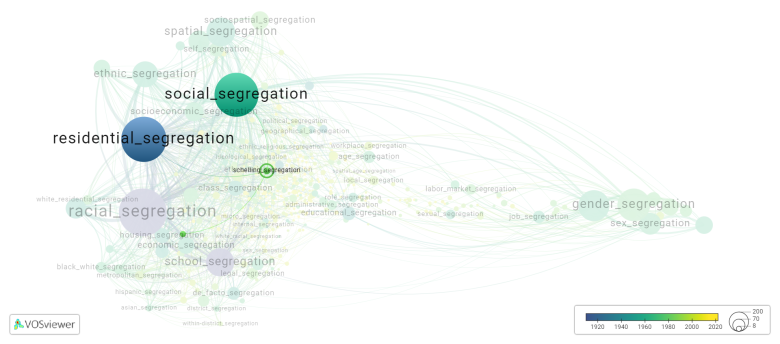Schelling segregation
Date and country of first publication[1][edit | edit source]
1991
United States
Definition[edit | edit source]
Schelling segregation refers to a theory developed by economist Thomas C. Schelling in the 1960s, which explains how even a preference for a small degree of segregation can lead to the formation of highly segregated communities. Schelling's model used a simple mathematical framework to illustrate this phenomenon.
According to Schelling, individuals have a threshold, or a certain level of tolerance, for the proportion of their neighbors that belong to a different social group or community. If the actual proportion exceeds an individual's threshold, they might find it uncomfortable and choose to move to a more homogeneous neighborhood.
In Schelling's model, agents are placed on a grid, where each agent is assigned a fixed threshold. Initially, the agents are scattered randomly. In each time step, an agent may decide to move to a vacant location if the proportion of their neighbors from a different group exceeds their threshold. This process of movement continues until no agent wishes to relocate.
The surprising outcome of Schelling's model is that even slight preferences for homogeneity can lead to the emergence of highly segregated residential patterns. Schelling showed that a relatively mixed distribution of agents in the beginning can quickly evolve into segregated clusters, with each group occupying separate areas.
Schelling's work highlights how individual preferences for similarity can perpetuate and reinforce segregation, even in the absence of explicit discrimination or animosity towards different groups. This theory has been applied to understand residential segregation, racial and ethnic segregation, and other social phenomena.
Synonyms[edit | edit source]
The following terms are synonymous with schelling segregation:
schelling residential segregation; schelling's neighborhood segregation; schelling's segregation.
References and literature addressing this segregation form under these synonymous terms can be found below.
See also[edit | edit source]
Related segregation forms[edit | edit source]
Schelling segregation is frequently discussed in the literature with the following segregation forms:
neighborhood racial segregation, social segregation, residential segregation

This visualization is based on the study The Multidisciplinary Landscape of Segregation Research.
For the complete network of interrelated segregation forms, please refer to:
References[edit | edit source]
Notes[edit | edit source]
- ↑ Date and country of first publication as informed by the Scopus database (December 2023).
At its current state, this definition has been generated by a Large Language Model (LLM) so far without review by an independent researcher or a member of the curating team of segregation experts that keep the Segregation Wiki online. While we strive for accuracy, we cannot guarantee its reliability, completeness and timeliness. Please use this content with caution and verify information as needed. Also, feel free to improve on the definition as you see fit, including the use of references and other informational resources. We value your input in enhancing the quality and accuracy of the definitions of segregation forms collectively offered in the Segregation Wiki ©.
Schelling segregation appears in the following literature[edit | edit source]
Clark W.A.V. (1991). Residential preferences and neighborhood racial segregation: A test of the schelling segregation model. Demography, 28(1), 1-19. https://doi.org/10.2307/2061333
Theobald D.M., Gross M.D. (1994). EML: A modeling environment for exploring landscape dynamics. Computers, Environment and Urban Systems, 18(3), 193-204. https://doi.org/10.1016/0198-9715(94)90024-8
Lieberson S., Dumais S., Baumann S. (2). The instability of androgynous names: The symbolic maintenance of gender boundaries. American Journal of Sociology, 10(5), 1249-1287. University of Chicago Press.https://doi.org/10.1086/210431
Laurie A.J., Jaggi N.K. (2003). Role of 'vision' in neighbourhood racial segregation: A variant of the schelling segregation model. Urban Studies, 40(13), 2687-2704. https://doi.org/10.1080/0042098032000146849
Ruoff G., Schneider G. (2006). Segregation in the classroom: An empirical test of the schelling model. Rationality and Society, 18(1), 95-117. https://doi.org/10.1177/1043463106060154
Marks R.E. (2007). Validating simulation models: A general framework and four applied examples. Computational Economics, 30(3), 265-290. https://doi.org/10.1007/s10614-007-9101-7
Crooks A., Hudson-Smith A., Dearden J. (2009). Agent street: An environment for exploring agent based models in Second Life. JASSS, 12(4), -. https://doi.org/
Singh A., Vainchtein D., Weiss H. (2009). Schelling's segregation model: Parameters, scaling, and aggregation. Demographic Research, 21(), 341-366. https://doi.org/10.4054/DemRes.2009.21.12
Grauwin S., Goffette-Nagot F., Jensen P. (2012). Dynamic models of residential segregation: An analytical solution. Journal of Public Economics, 96(1-2), 124-141. Elsevier B.V..https://doi.org/10.1016/j.jpubeco.2011.08.011
Bersini H. (2012). UML for ABM. JASSS, 15(1), -. https://doi.org/10.18564/jasss.1897
Baldwin W.C., Boardman J.T., Sauser B.J. (2013). Expanding a System of Systems Model with the Schelling Segregation Model. Systems Research and Behavioral Science, 30(1), 65-75. https://doi.org/10.1002/sres.2115
Barde S. (2015). Back to the Future: Economic Self Organisation and Maximum Entropy Prediction. Computational Economics, 45(2), 337-358. Kluwer Academic Publishers.https://doi.org/10.1007/s10614-014-9422-2
Chie B.-T., Chen S.-H. (2015). The use of knowledge in prediction markets: How much of them need he know?. Journal of Information Science and Engineering, 31(1), 1-22. Institute of Information Science.https://doi.org/
Urrutia-Mosquera J., López-Ospina H., Sabatini F., Rasse A. (2017). Tolerance to diversity and residential segregation. An adaptation of the Schelling segregation model with three social groups; [Tolerancia a la diversidad y segregación residencial. Una adaptación del modelo de segregación de Schelling con tres grupos sociales]. Eure, 43(130), 5-24. Revista de Geografia Norte Grande.https://doi.org/10.4067/s0250-71612017000300005
Troitzsch K.G. (2017). Axiomatic theory and simulation: A philosophy of science perspective on schelling’s segregation model. JASSS, 20(1), -. University of Surrey.https://doi.org/10.18564/jasss.3372
Gretha O.B., Cristal P.M., Mauhe N. (2018). Segregation in social networks: A simple schelling like model. Proceedings of the 2018 IEEE/ACM International Conference on Advances in Social Networks Analysis and Mining, ASONAM 2018, 95-98. Institute of Electrical and Electronics Engineers Inc..https://doi.org/10.1109/ASONAM.2018.8508751
Tarko V., Gangotena S.J. (2019). FREEDOM OF ASSOCIATION AND ITS DISCONTENTS: THE CALCULUS OF CONSENT AND THE CIVIL RIGHTS MOVEMENT. Research in the History of Economic Thought and Methodology, 37B(), 197-221. Emerald Group Holdings Ltd..https://doi.org/10.1108/S0743-41542019000037B021
